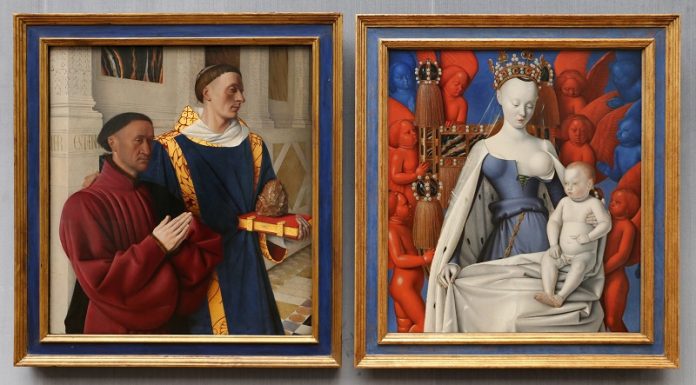
Imagine you’re looking at an old painting from France, and you notice something that looks like a stone tool from a very, very long time ago.
That’s what some smart researchers found when they looked closely at a famous French painting from the 15th century.
Long ago, more than 500,000 years back, early humans used big stone tools called “Acheulean handaxes.”
They used them to cut meat, chop wood, and dig in the ground. These tools, often made from a rock called flint, looked like big teardrops with pointy ends.
For a long time, people didn’t know what these stone tools were. They thought they fell from the sky during thunderstorms and called them “thunderstones.”
The first time someone wrote about these “thunderstones” was in the mid-1500s.
But now, some researchers from Dartmouth and the University of Cambridge have found what they think is a picture of one of these stone tools in a famous painting.
The painting is called “The Melun Diptych,” made around 1455 by an artist named Jean Fouquet.
This painting was made for a man named Étienne Chevalier, who was a big deal because he took care of money for the French king.
The painting is made of two parts. In one part, you can see Chevalier looking like he’s praying.
Next to him is Saint Stephen, a saint known for being hit with stones. On top of a book that Saint Stephen is holding, there’s a stone that looks just like one of these ancient tools!
For a long time, art experts just thought it was a pointy rock. But one art teacher, Steven Kangas, always thought it looked more like an old tool. He decided to find out more when he heard a talk about a place in Tanzania famous for these stone tools.
After the talk, Kangas showed the painting to some other professors who know a lot about early humans and their tools. They all thought the stone in the painting looked like a handaxe.
To be sure, the researchers did some fancy studies on the painting. They looked at the shape of the stone and found it looked a lot like other old tools from France.
They also looked at its colors and found it matched other handaxes. They even counted the marks on the stone in the painting and found it matched real tools!
James Clark, a student helping with the study, said the painting’s stone looked so much like other old tools from the same place where the artist lived.
It’s cool to think about how these old tools connect us through time. From early humans using them for survival, to a French artist possibly seeing one and painting it, these tools have been a big part of our history.
Jeremy DeSilva, another smart person from Dartmouth, said he loves the idea of an old tool being in a famous painting. “From a time when humans were just starting out to fancy art from long ago, these tools have always been with us,” he said.
So, the next time you look at an old painting, take a close look. You never know what ancient secrets might be hiding in plain sight!
Follow us on Twitter for more articles about this topic.
Source: Dartmouth College.



